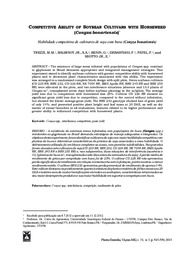Competitive ability of soybean cultivars with horseweed (conyza bonariensis).
Competitive ability of soybean cultivars with horseweed (conyza bonariensis).
Author(s): TREZZI, M. M.; BALBINOT JUNIOR, A. A.; BENIN, G.; DEBASTIANI, F.; PATEL, F.; MIOTTO JR. E.
Summary: ABSTRACT: The existence of large areas infested with populations of Conyza spp. resistant to glyphosate in Brazil demands appropriate and integrated management strategies. This experiment aimed to identify soybean cultivars with greater competitive ability with horseweed plants and to determine plant characteristics associated with this ability. The experiment was arranged in a randomized complete block design with split plots. Seven soybean cultivars (CD 225 RR, BRS 232, CD 226 RR, NK 7054 RR, BMX Apollo RR, BRS 245 RR and BRS 255 RR) were allocated in the plots, and two interference situations (absence and 13.3 plants of Conyza m-2, transplanted seven days before soybean planting) in the subplots. The average yield loss due to competition with horseweed was 25%. Cultivar CD 226 RR showed no significant grain yield loss due to competition, compared to the control without infestation, but showed the lowest average grain yield. The BRS 232 genotype showed loss of grain yield of only 14%, and presented positive plant height and leaf mass at 20 DAE, as well as dry matter of stems+branches in all evaluations, features related to its higher performance and greater ability to withstand competition with horseweed plants. RESUMO - A existência de extensas áreas infestadas com populações de buva (Conyza spp.) resistentes ao glyphosate no Brasil demanda estratégias de manejo adequadas e integradas. Os objetivos deste experimento foram identificar cultivares de soja com maior habilidade competitiva com plantas de buva e determinar características de plantas de soja associadas a essa habilidade. O delineamento utilizado foi em blocos completos ao acaso, com parcelas subdivididas. Nas parcelas foram alocados sete cultivares de soja (CD 225 RR, BRS 232, CD 226 RR, NK 7054 RR, BMX Apollo RR, BRS 245 RR e BRS 255 RR) e, nas subparcelas, duas situações de interferência (ausência e 13,3 plantas de buva m-2, transplantadas sete dias antes da semeadura da soja). A perda média de rendimento de grãos por competição com buva foi de 25%. O cultivar CD 226 RR não apresentou perda significativa de rendimento em relação à testemunha sem infestação, porém mostrou o menor rendimento médio. O cultivar BRS 232 apresentou perda percentual de rendimento de apenas 14%. Este cultivar destacou-se positivamente quanto à estatura de planta e matéria de folhas secas aos 20 DAE e matéria seca de caules+ramificações em todas as avaliações, características relacionadas ao seu maior desempenho produtivo e sua maior habilidade em suportar a competição com buva.
Publication year: 2013
Types of publication: Journal article
Unit: Embrapa Soybean
Keywords: Buva
Related content
Observation
Some of Embrapa's publications are published as ePub files. To read them, use or download one of the following free software options to your computer or mobile device. Android: Google Play Books; IOS: iBooks; Windows and Linux: Calibre.
Access other publications
Access the Agricultural Research Database (BDPA) to consult Embrapa's full library collection and records.
Visit Embrapa Bookstore to purchase books and other publications sold by Embrapa.


